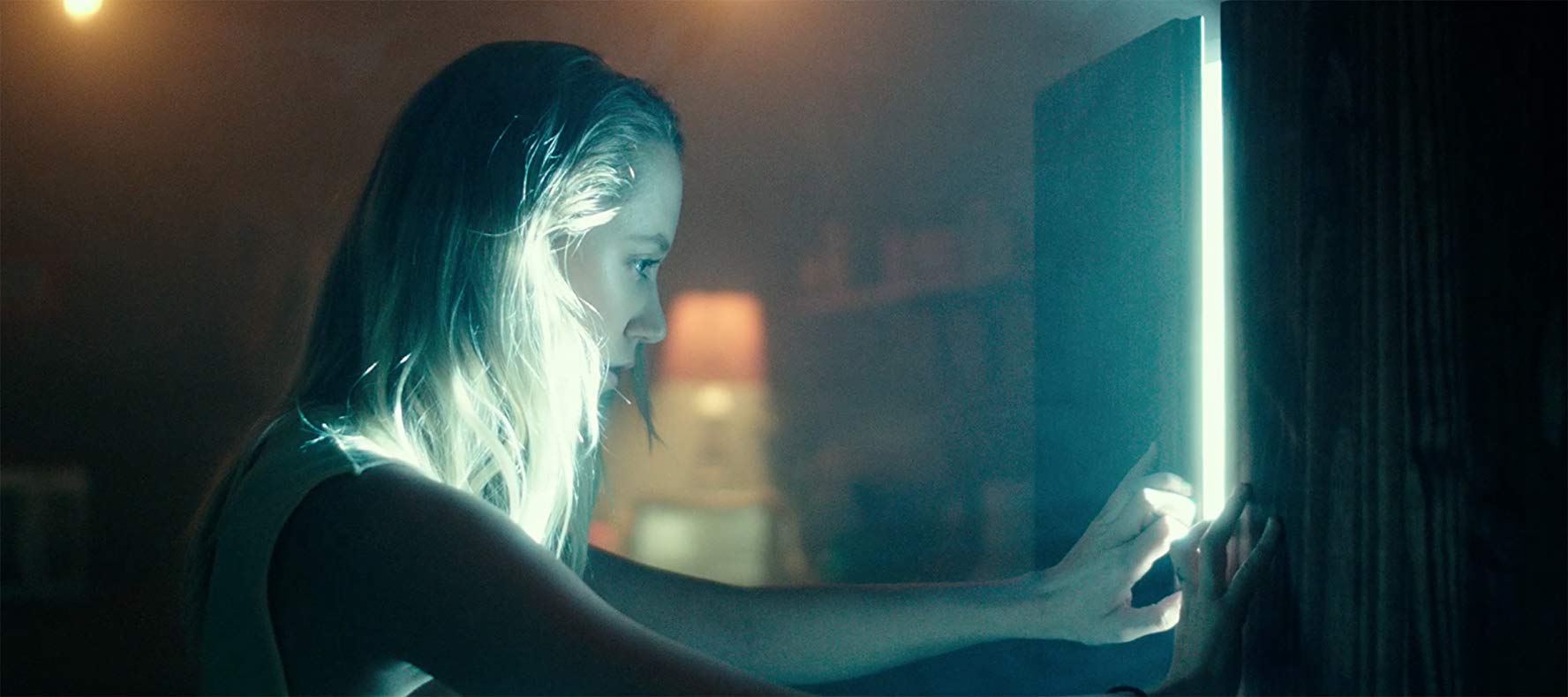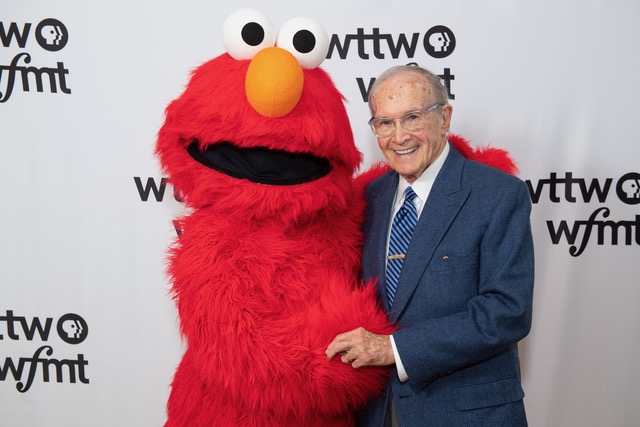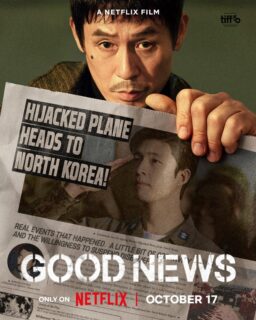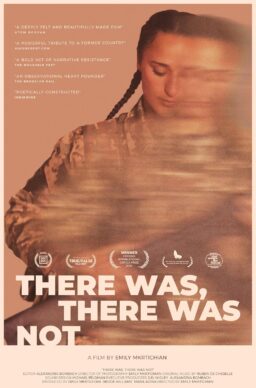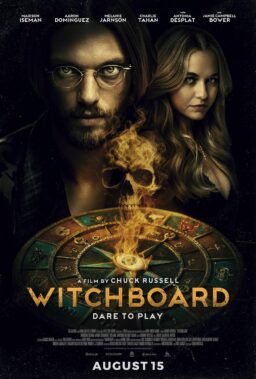Do you remember being left home alone as a kid? When your parents felt you were old enough to handle an evening by yourself without the need of a babysitter? I do. There was nothing to it, really. Put in a Stoffer’s TV dinner, throw in a VHS with three movies on it (maybe scary, maybe not), wait for “Saturday Night Live” to come on at 10:30 and fall asleep until they came home. Nice and simple for a kid in the suburbs. As long as I had my movies playing, every light in the house turned on and the cat to keep me company, all was well. Every kid should have this experience, but I’m guessing with all the ramped up suburban paranoia and the helicopter parenting going on, I bet many kids are missing out.
Kate Trefry’s “How To Be Alone” takes an adult perspective on being left alone in the house for an evening with a film that is dark, creepy, sneakily funny and very real in the most unsettling way. The main character, a photographer named Lucy (Maika Monroe, from “It Follows” and “Greta”), stays home while her husband (“Stranger Things”’ Joe Keery) works the night shift at a hospital. She makes a plan for herself in order to ease the tension: Organize her studio, paint her nails and eat cereal.

While she mainly sticks to that plan throughout the night, she cannot escape an anxiety closet (to borrow from Berke Breathed’s “Bloom County”) full of real-life terrors that manifest in some form or another: A baby, a snake, a mysterious person in a gimp outfit and something else otherworldly. All of it exists in the dead of night when Lucy is at her most vulnerable and forced to confront some uncomfortable truths about her life, her marriage, the choices she has made and what to do next. “Call something harmless. Watch it destroy you,” she often says.
Trefry, who also writes for “Stranger Things,” employs voice-over for much of the film, which some may view as a crutch, but I cannot imagine the movie without it. After all, when one stays home alone, talking to one’s self sometimes helps as a coping mechanism and that’s what Lucy must do in order to make it through the night. Monroe gives a perfectly nuanced performance as Lucy’s personal horrors are more deeply felt and the manifestations of them become terrifying.
This is an incredibly strong debut from Trefry, who has the right instincts for visually presenting psychological horror while keeping the viewer on edge. Important details aplenty lurk throughout the frame, and I notice something new every time I watch it. Caleb Heymann’s cinematography is exquisite, always foreshadowing with a blue light emitting from another part of the house we have yet to see. David Pergolini’s editing keeps the pace brisk, complimented by a wonderfully pulsating, retro horror score by Michael Dean Parsons and John Kaefer. The film is as much fun to listen to as it is to watch.
For best effect, watch “How to Be Alone” in the darkest hours of the night, all the lights off, when no one else is home.
Q&A with writer/director Kate Trefry.
How did this idea come about?
The idea came from an actual kitchen cupboard in my apartment. When my husband and I first moved in, we found a horrible looking old bible in a kitchen cabinet. I didn’t know if it was worse to keep it or throw it away, so my compromise was to leave it there and just never open the cupboard again. With that as a jumping off point, I wanted to make a film about female identity, codependency, and pregnancy anxiety (I was five months pregnant when we shot the short).
Can you tell me about any challenges involved in having a baby and a snake on the set?
We had to shoot the snake and baby out on the same day, which I was really worried about until it became clear that the snake was super lazy and just wanted to sleep in his basket. Also our baby and his parents and brother were all extremely mellow about everything, from the blood to the cupboard gag to the fact that there was a seven foot python chilling in the next room.
How was working with Maika Monroe? What was the process and/or collaboration like?
Maika Monroe is incredible and I want to work with her — and Joe Keery — in everything. From the moment she read the script, she absolutely got it on every level, not just the struggling with your demons part, but also the gallows humor, which is was so crucial to me. And somehow she’s able to communicate it all in a glance. I was extremely lucky to have her, and the rest of that amazing cast and crew, roll the dice on me as a first time filmmaker.
Another film you co-wrote, “Souls of Totality”, shared some similar themes, including a character coming to terms with certain truths during the darkest part of the day and coming out the other side when the sun is back out. Do you see these films as two parts of a whole? And is there something that draws you to that idea?
I never considered the thematic connection with “Souls of Totality”, but I will say writing that short and then being so involved in production, shooting, and post, definitely inspired me to write and direct my own short. The same amazing producers, 4WT, worked on both shorts, and with them in my corner, as well as Valparaiso, it all suddenly became possible.
This feels like a horror movie with a unique approach and many will be able to relate to anxieties within the main character. For you, what is the central horror taking place here?
Yes! So if I were labeling it, I would probably call How to Be Alone an existential horror story. I’ve always thought anxiety gets the short end of the stick in cinematic depictions: it’s usually just someone looking sweaty and confused (or if it’s a woman, sweaty and hysterical), because that’s how it looks on the outside. But I wanted to peel back the skin and submerge into the terror that is the anxiety spiral, complete with the paranoid inner monologues, and depict the inevitable final face off with the beast of fear itself, which I think in those moments feels like some unknowable, Lovecraftian monster.
The lighting seemed very specific (particularly that blue light, the source of which isn’t revealed until much later). How did you and your cinematographer, Caleb Heymann, approach the look of the film?
Caleb is the kind of incredibly talented DP who can listen to someone like me string off a bunch of adjectives and somehow immediately translate that into a lighting set up that communicates that exact thing. I wanted this short to have a surreal, uncanny, domestic dread vibe to it (there I go with the adjectives), Gregory Crewdson was a big reference, but it was also important to me that it never got too dark, too dreary. I think Caleb walked that line brilliantly. We wanted to be able to move fluidly between the imagined and the real, so the whole thing has a dreamy quality to it that I love.
Has writing on “Stranger Things” in any way, informed or influenced your work on this film?
Writing on “Stranger Things” and visiting set has definitely influenced my work. One of my favorite things about the show is the pacing and the energy. The Duffers are amazing at maintaining that breathless, breakneck, binge-y speed to their narratives, and at walking the tonal line between horror and humor. How to Be Alone was definitely my experiment in trying to hone those skills.
What’s next for you?
I just finished writing on a horror trilogy that Caleb is actually currently shooting, and am now back writing season 4 of “Stranger Things.” In my nonexistent free time, I hang out with my awesome baby and am working on what I hope will be my feature directorial debut, a very dark coming of age story about a female friendship.

